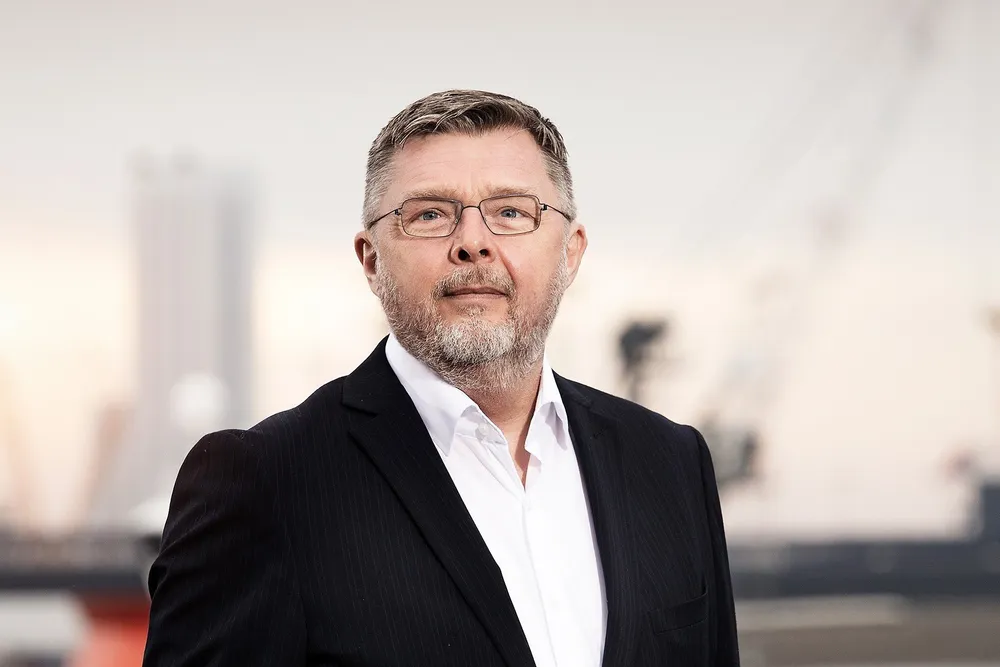Danish port chief talks Trump tariffs, Mingyang and offshore wind losers
‘I look out of my window and see components that should be in the US,’ says Port Esbjerg COO on disruption caused by Trump tariffs

Trump has used tariffs – “the most beautiful word in the dictionary,” according to the US President – as a political sledgehammer since his return to the White House, threatening friends and foes alike on the international stage.
The latest stage of a seemingly endless cycle of threatening, implementing and withdrawing tariffs has found the EU on notice of a planned 30% tariff on goods, causing major headaches for suppliers like Siemens Gamesa and Vestas, who have various agreements to export offshore wind turbines to the US.
“We will have components in our port that are bound for the US market which are not being shipped in due time,” he said – not just for offshore wind, but for other commodities too.
Looking out his office over the vast, sprawling port, which covers more than 4.5 million square metres, “I can see components that should be in the US now,” said Bank. “But they’re not there. They’re outside my window.”
Port Esbjerg - a short history
Port Esbjerg was founded in 1874 after Denmark lost another port in what is now modern-day Germany in the second Danish-Prussian War. In the 150 years since then, Port Esbjerg has transformed from principally serving the fishing industry to becoming a leading global hub for the export of wind turbines.
Port Esbjerg has in particular become a pacesetter in serving the offshore wind industry as the sector has grown since the turn of the century. In fact, Port Esbjerg claims that more than 80% of Europe’s current installed offshore wind capacity has been shipped out of its docks.
The current upheaval emanating from the US is causing significant uncertainty for Port Esbjerg customers. Bank said he has asked when components they have sitting in the port will be shipped out. “And they're not able to tell us.”
“That might be in one month or in three months.”
Obviously this “has a price” for customers – Esbjerg real estate does not come cheap – but Bank said this is not necessarily the primary issue, for the port at least.
“The issue is that if we have dead components in the port that will block other activities,” he said. “That's a high price to pay.”
“Our income flow is from activity. We don't live from having dead components in our port. Even though they pay rent, we would rather have a throughput than just dead components. And that could be cars or industrial components or it could be turbines.”
Bank declined to comment on which specific wind turbine components, and from which suppliers, might have found themselves stranded in Esbjerg as a result of US upheaval. But Vestas and Siemens Gamesa are both supplying major offshore wind projects in the US.
Whatever the trouble unleashed by Trump’s tariffs, Bank stressed that these are “short-term concerns,” stressing that the need for the cheap, clean power that offshore wind can provide is not going anywhere.
“That doesn't take away the concerns,” but they are not “structural,” he said. “If you are robust enough and if you can think long-term, we are not super worried.”
‘Who wants to invest in an industry with more losers than winners?’
One issue that is structural, and is a real concern for Port Esbjerg, is the offshore wind market itself, said Bank.
Simply put: “There are too few auctions.”
“When you have an auction, you will have one winner and five losers,” he said. “And that wouldn't be a problem if there were another auction tomorrow... but there's not.”
“This industry right now is creating more losers than winners,” said Bank. “That in terms of outlook is a bit difficult.”
“Who wants to invest in an industry that the probability of being a loser is bigger than being a winner?”
The market structure is not mature enough or robust enough to give the security that many of its supply chain players need, said Bank. And if it affects the supply chain, “then it affects the ports.”
Despite the troubles around auction rounds, Bank strikes an optimistic note that, whatever the “ups and downs, we are confident that there will be an industry in 10 years.”
‘Would we host Mingyang? It’s difficult’
If Mingyang were to knock on Bank’s door in the coming years and ask if there was any room to set up shop next to Vestas and Siemens Gamesa, what response would they get?
“This is difficult,” said Bank. “We are serving the customers that we have. And we don't throw customers out the window.”
“We have been talking about the Chinese for five, eight years, right? But they are not really present yet.”
Europe is not an “easy market” to crack, he added.
Bank stressed that it’s not necessarily just because they’re Chinese that the European market is difficult, it’s difficult full stop.
More generally, Bank said that, as a port, “we reflect the society and the companies that are around us.”
“The companies around us, they deal with whoever they deal with,” he said. “It's actually not up to the port to decide Vestas, Siemens, Mingyang. This is not a port issue, right?”
“We serve the customer,” he said, “wherever they source their components.”
“So we serve our society and the companies that are here. And it's kind of first come, first served market.”
“We don't have a strategy to exclude anything. But we have a strategy to serve the customers that we have.”
(Copyright)